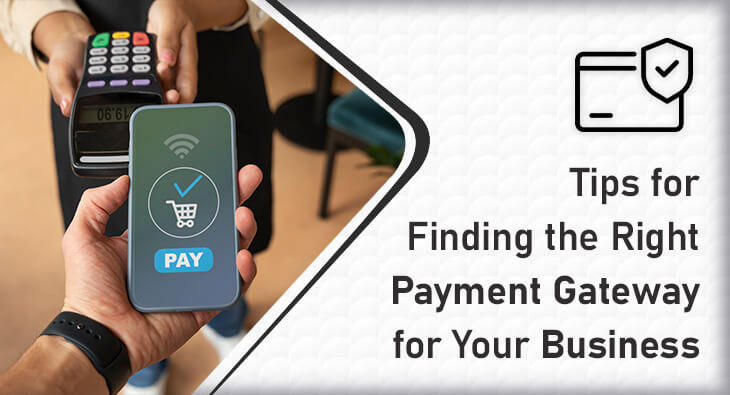If you are planning to take your business online, one of the most critical things you need to consider is the payment gateway you will use. Choosing the right payment gateway is a critical decision that will significantly impact the success of your business. A payment gateway is software that processes transactions and ensures secure online payments for your customers. With several payment gateways available in the market, selecting the right payment gateway can be an overwhelming task. In this blog post, we will discuss some essential tips that will guide you in finding the right payment gateway for your business.
Define your business needs
When looking for the right payment gateway for your business, the first thing you need to do is to define your business needs. Every business is different and has unique requirements. Therefore, it is important to determine what you need from a payment gateway.
Here are some questions to ask yourself when defining your business needs:
1. What payment methods do you want to accept?
2. How many transactions do you expect to process?
3. Do you need recurring billing or subscription options?
4. What level of security do you require?
5. Do you need integration with your e-commerce platform?
6. Do you need international payment capabilities?
Answering these questions will help you to narrow down your search and find a payment gateway that meets your specific requirements. Make sure you have a clear understanding of what you need before you start comparing options.
Some Related Blogs
- Mastering the Art of Handling ACH Disputes – Merchant Stronghold
- 5 Proven Strategies to Prevent and Recover Failed Payments
- Payment Orchestration for Seamless Payment Processing
- Mitigating Risks with High-Risk MCC Codes
Consider your target market
When selecting a payment gateway for your business, it’s essential to keep your target market in mind. The payment preferences of your customers can vary greatly based on factors such as age, location, and industry. Some payment gateways cater to specific regions, while others may offer a wider range of payment options that may not be as relevant to your target market.
For example, if you are targeting younger audiences, it’s important to choose a payment gateway that offers mobile-friendly payment options. On the other hand, if your target market is primarily in a certain geographical location, it’s best to select a payment gateway that supports the payment options used in that area.
Also, some industries have specific payment requirements, such as the travel and hospitality industry that require payments in multiple currencies or installment payments. So, before selecting a payment gateway, make sure to assess the unique payment preferences and requirements of your target market.
To get a better understanding of your target market’s payment preferences, you can also conduct surveys or ask for feedback from your customers to find out what payment methods they prefer. By doing so, you can ensure that you are selecting a payment gateway that caters to your customer’s needs, ultimately resulting in increased customer satisfaction and better sales conversions.
Compare pricing
When choosing a payment gateway, it’s important to consider the cost involved. Most payment gateways charge a transaction fee, which is a percentage of the total sale. The percentage fee can vary depending on the payment gateway, and some also charge a flat fee per transaction.
Make sure you compare the pricing structure of different payment gateways before choosing one. Some gateways offer volume discounts or lower fees for nonprofit organizations. Additionally, some payment gateways may require setup or monthly fees.
When considering pricing, keep in mind that the lowest cost may not always be the best option for your business. The cheapest payment gateway may have limited features or a subpar customer support team. Instead, consider the value of the payment gateway in terms of the services it offers.
Also, be aware of any hidden fees that might arise when using certain payment gateways. For instance, some gateways may charge a fee for chargebacks, refunds, or API access.
By taking the time to compare pricing and understand the full cost structure of each payment gateway, you can choose the one that fits best with your business’s budget and goals.
Consider ease of use
Once you have determined your business needs and identified the payment gateway options that cater to those needs, the next factor to consider is the ease of use. An easy-to-use payment gateway can significantly impact your customers’ shopping experience and boost your overall revenue.
When evaluating payment gateways, check whether they offer simple and straightforward integration with your online store. An intuitive user interface, well-documented API, and reliable technical support can go a long way in making your integration process seamless and trouble-free.
Consider also whether the payment gateway provides a smooth and hassle-free checkout experience. Customers want to make purchases without unnecessary obstacles, and any inconvenience may result in cart abandonment. Therefore, it’s crucial to ensure that your payment gateway offers a streamlined checkout process, allowing customers to complete transactions in a few clicks.
Moreover, mobile compatibility is critical in today’s age of online shopping. Make sure that the payment gateway supports mobile devices and is optimized for a mobile shopping experience. Many consumers now use their mobile phones to shop online, and you don’t want to lose potential sales because your payment gateway isn’t mobile-friendly.
Finally, consider whether the payment gateway is customizable and scalable, which means it can grow and adapt to your business’s evolving needs. Flexibility in terms of adding or modifying payment methods and features can give you the freedom to optimize your payment process further.
In summary, when selecting a payment gateway, prioritize ease of use and focus on providing your customers with a seamless, hassle-free checkout experience. Doing so can lead to improved customer satisfaction, higher sales, and more business growth.
Read online reviews
One of the best ways to get an idea of the experience that others have had with a payment gateway is by reading online reviews. This is particularly important if you are considering using a new or less established payment gateway, as there may be limited information available on the company and its products.
When looking at online reviews, try to find a range of sources that are reliable and reputable. This could include reviews on the payment gateway’s own website, as well as independent review sites like Trustpilot, Capterra, or G2. These platforms can be particularly useful because they often allow customers to leave detailed feedback on their experience with the payment gateway, including any challenges or issues that they may have faced.
When reading reviews, keep in mind that one or two negative reviews shouldn’t necessarily be a dealbreaker, as even the best companies will occasionally have unhappy customers. Instead, look for patterns in the reviews, such as frequent complaints about poor customer service, slow processing times, or hidden fees.
Ultimately, the insights you gain from online reviews should be just one factor in your decision-making process, but they can provide valuable context and help you make a more informed choice.
![]()
Email us anytime!
Email customer service 24/7
![]()
Call us anytime!
Reach customer care 24/7 at +1 (727) 330-3944


